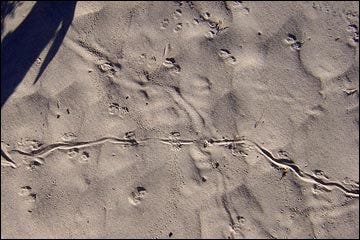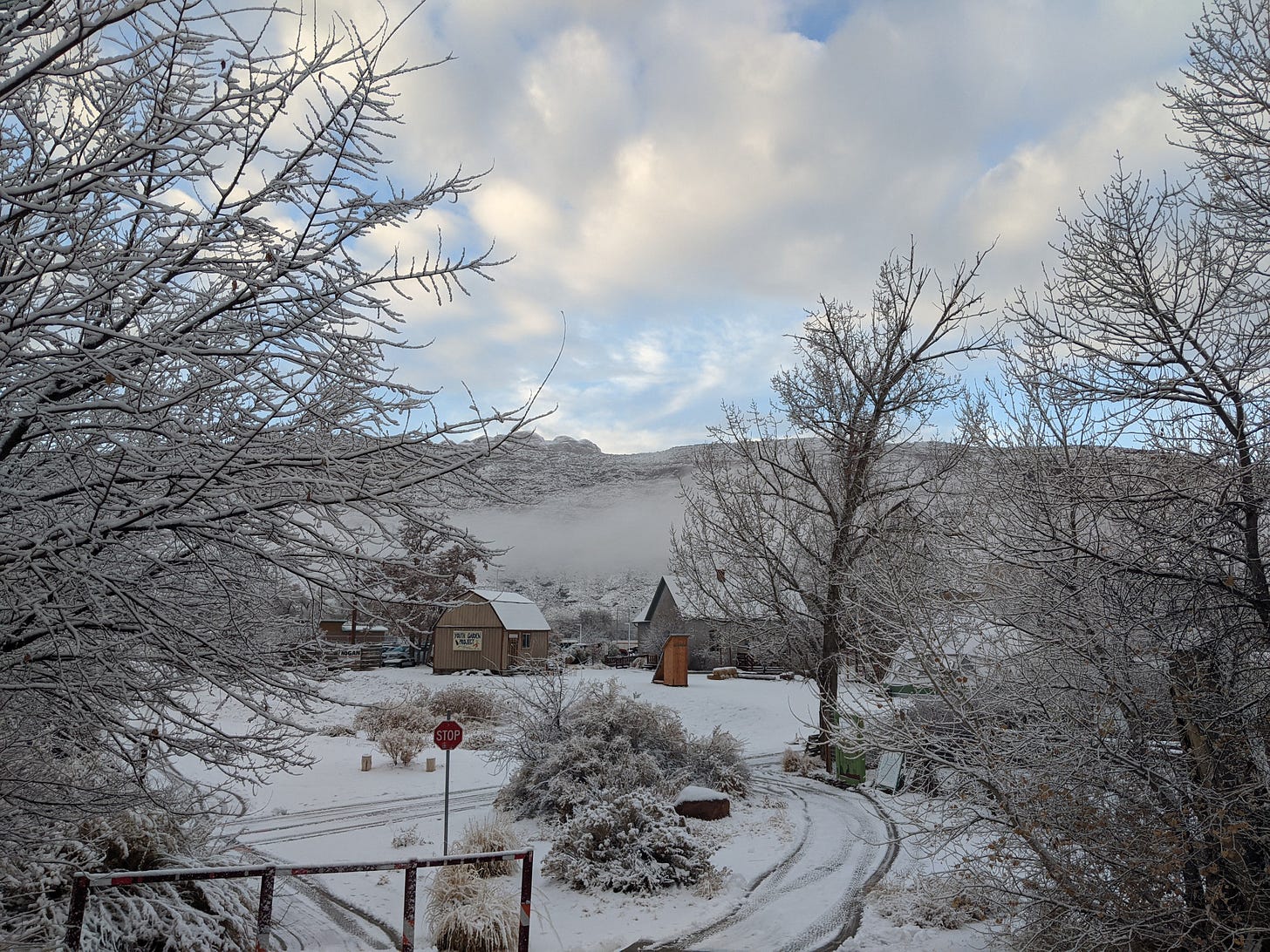🐾 Animal Tracking | Issue #22
Three personal stories of sharing places with animal neighbors, and how tracking can help develop our sense of place
Placeful is a weekly newsletter exploring sense of place, sustainability, and the actions we can take to more deeply engage with our communities and wild spaces. Each week covers a new topic. To learn more about the “why” behind Placeful, start here.
Any books mentioned in this issue may be found on my bookshop shelf. I may earn a commission from books purchased through these links, at no additional cost to you.
I.
As a child growing up on a small acreage in rural South Dakota, I was obsessed with the idea of secret hideouts. I had one in the woods on our property, really just a stand of trees between our house and the neighbor’s. A road used to run through it, and tree branches still curved over the forgotton passageway. I also had one behind an old farm building—a small clearing with a couple trees and a few meters of fencing that didn’t hold anything in or out, leftover from a different time in the farm’s 100 year history.
My dad noticed my penchant for forgotton nooks and crannies around the 10 acre property, and brought a few old trees stumps to the clearing for us to sit on. While we were dwelling together in the space, my dad pointed out that one of the trees had a “deer rub,” where a buck had stripped away the bark with its antlers. I thought about what it meant for us and this deer to share a space—Why did he come here? Why this particular tree? Did he love this space as much as I did?
II.
Snow in the desert, if you haven’t seen it, is really magical. That’s what I was thinking about as I walked to work on one wintery morning this January. A fog was hanging around the valley, high enough that it wasn’t covering the ground, but low enough that it didn’t rise over the Rim. Snow sat on shelves in the rock, creating a beautiful, layered effect of white on orange on the valley’s Southern edge, which sits in the shade for much of the day.
It was my turn to feed the farm cats, Pumpkin and Butternut, when I arrived at work this snowy morning. As the first one there, I feel hesitant about ruining the perfect, white snow with my footsteps. That is, until I see little kitty pawprints in the snow between our “sunken classroom” and the kitchen door.
I’m not sure there is anything quite as precious as the careful tracks a cat leaves in a few inches of snow. It reminds me of how all of our garden animals—and many others who enjoy the space, too—have lives beyond the 8 hours that us humans are there each day. And they too catalog the places that have meaning to them, like the kitchen door their food emerges from each morning.
III.
It’s a warm spring day, and Garrett and I have decided to spend it in Arches National Park. Spring is my favorite season for many reasons, the first being that I was born on its first full day. It also competes with autumn in Moab as the absolute best time to recreate, the weather being not too hot or too cold. Everything awakens in spring, a new color palette takes over, and the soil and flowers and chlorophyl work together to sustain, renew, and carry on.
Midway through our hike, one critter has certainly found the season’s weather appealing enough to venture out. In the sand rising over the edge of the trail, a collection of tiny rodent footprints appears, with a wiggly line running through them. Garrett says these are most likely mouse tracks, and that the line is from its tail. The sand was fine enough to catch this, the tiniest detail of this desert critter’s travels. I wonder—What does it feel like to be a mouse walking across the sand? To drag your tail behind you in the warm, shifting ground? What does the coming of spring mean for it?
What is tracking?
At its core, animal tracking depends on having a deep understanding of precisely how and why everything in nature is intimately interconnected.
- Brian Mertins, Naturalist
More specifically, animal tracking is the process of collecting clues from our environment to interpret animal behaviors and locations. Animal tracks are, of course, the impressions their feet, claws, and paws leave in the ground, whereas animal signs include scat, deer rubs, feathers, dens, and other impressions in the landscape that tell the story of an animal’s behaviors. Snow and sand are ideal conditions for beginner trackers to start training their eyes, and learning to pick up subtle clues from their environment.
Practiced trackers can tell a lot from tracking, including speed of travel, sex of the animal, days passed since the impression was made, why it was passing through the area, and/or other interesting details of a particular animal’s life. Trackers gain these skills through practice and over time, and as they progress in their skill, can start picking up even subtler signs.
People have been tracking animals for thousands of years. Until agriculture was invented, and even after, tracking was important for survival. Not many people today are expert trackers though—the need for this skillset is not the same as it once was. However, there are still many other reasons that people get into tracking, and connecting to place or learning more about our bioregions are both great reasons to get into it.
Crossing paths
Hunters, wildlife managers, and wildlife researchers need to understand the movements of animals to accomplish or achieve something. For the rest of us, though, tracking is a friendly practice, a way of getting to know our fellow earthbound neighbors. Tracks and other signs provide insight into their lives, including their travels, motivations, and intentions. Animals are fascinating, and tracking gives us a view into their worlds.
When we pay attention to tracks and signs, we are engaging not only with the question of who was here before us, but also why they were here, where they are going, what was their purpose at this particular moment, and so on. We might be on a hike, or enjoying a day at the beach, but the animal whose track we have spotted came there for an entirely different purpose (though I do love the idea of a long-legged bird going on a hike).
Just like the same place can mean something different to each person, it also means something different to each living being that is there, too.
Animal tracking is just one of the subtle ways that we can learn to re-direct our attention outside of ourselves. Humans, lizards, coyotes, mice, cats, deer—we are all sharing this world together. Sometimes it’s good to be reminded.
So, next time you venture out on a snowy day, walk along a beach, or over the soft ground after a rain shower, look around. Perhaps something nonhuman made this journey before you.
What does this place mean to you? What does this place mean to them?
Where are you both heading next?
With love,
Emily
Resources
Check out this detailed guide to animal tracking from the Outdoor Action program at Princeton.
I have to share this book that most definitely ingrained itself in my childhood psyche.
I can’t claim to have tried it yet, but there is an app that helps with animal tracking available on Apple and Android that seems very interesting!
Placeful Practice
On your next outing, take a look around and see if you can find a print or sign of an animal! Even if it’s just a doggie paw print, it will still help you practice paying attention.
Have you seen any cool tracks or signs lately? Share them with the Placeful community at the link below!
Placeful is a weekly email newsletter containing personal reflections and reporting on sense of place and sustainability. Each week I delve into a new topic, wrapping it up with an action item that will help readers foster deeper connections to the natural, cultural, built, and historic environments around them. Read more about Placeful.
To find a web version of this issue, click here. Know someone who would appreciate the topics I’m writing about? Please share! If you’d like, you can follow me on Twitter (@emily_ann_again) or Instagram (@emily.a.roberson). My inbox is always open at placeful.emily@gmail.com. And lastly, if someone forwarded this to you, subscribe below to receive future issues straight to your inbox. Thanks for reading <3







